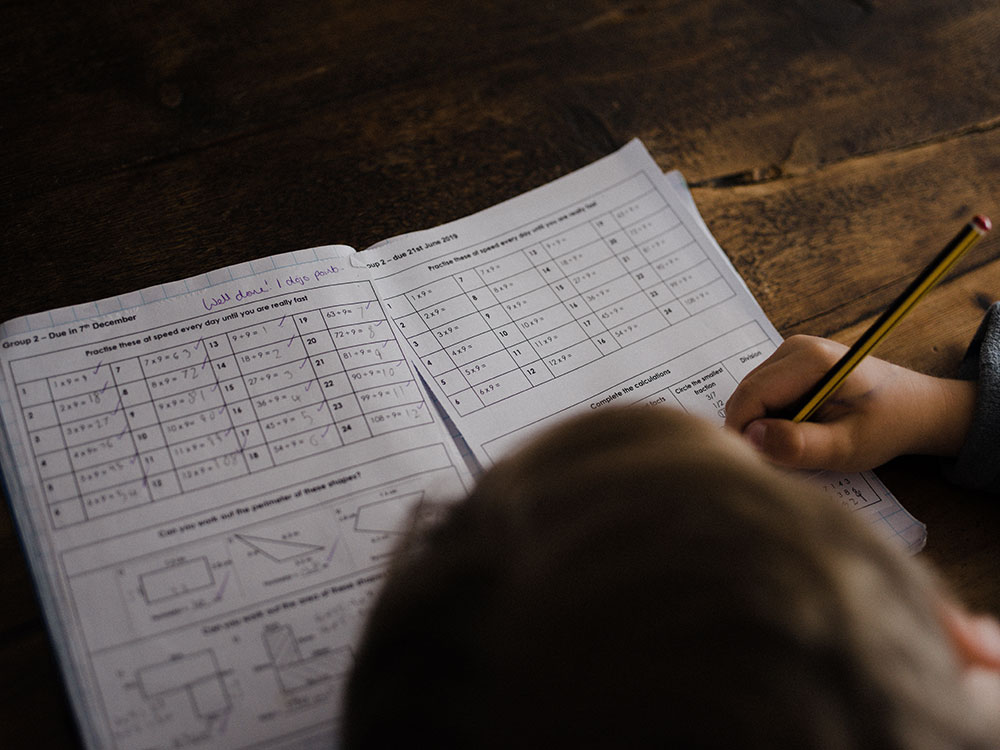New IPR Research: October 2021
Get all our news

This month's new research from IPR faculty examines stress and high-stakes testing among students from low-income backgrounds, the disproportionate school punishment of Black students and their life outcomes, and the effects of early government-subsidized preschools. Additionally, it investigates what Americans know about politics, how social media can influence attitudes about the flu vaccine, and early childhood obesity interventions.
Social Disparities & Health
Stress and High-Stakes Testing Among Students from Low-Income Backgrounds
Testing impacts students’ lives in many ways, including graduation and college admissions, but few studies have explored how students physically respond to tests. In Education Finance and Policy, IPR developmental psychobiologist Emma Adam, IPR education economist David Figlio, and Jennifer Heissel, former IPR graduate research assistant, now at the Naval Postgraduate School, compare the stress levels of 93 students in grades 3–8 during a typical school week, a low-stakes testing week, and a high-stakes testing week, as well as their test performance. To determine students’ stress levels, the researchers collected saliva to measure the stress hormone cortisol. During each week, participants provided six saliva samples over 24 hours. All the students attended a charter school in New Orleans, and most were Black and from low-income backgrounds. The results show that students’ stress was 18% higher during a high-stakes testing week than the non-testing week, with male students’ stress rising the most. The researchers find that male stress increased 31% during low-stakes testing and 33% during high-stakes testing. Females had no significant changes. Compared with girls, boys’ stress is 35% higher during testing weeks. Also, the results show a decrease in test scores on high-stakes tests when students’ stress increased or decreased by more than 10%. As high-stakes testing continues to play a role in students’ lives, this research helps schools and policymakers understand how students physically respond to tests and their test performance. Additionally, the researchers propose how schools can help reduce stress among students, including mindfulness programs, mental health interventions, and yoga. David Figlio is the Orrington Lunt Professor of Education and Social Policy. Emma Adam is the Edwina S. Tarry Professor of Human Development and Social Policy.
Disproportionate School Punishment of Black Students and Life Outcomes
Racial disparities exist in school disciplinary practices, with Black students being more likely to receive punishment than White students. In Psychological Science, IPR health psychologists Edith Chen and Greg Miller, along with their colleagues, study the relationship between racial inequalities in the punishment of Black students and their long-term outcomes. The researchers used data from an 18-year longitudinal study of 261 Black young adults—91 male and 170 female—from working- poor households in rural Georgia. The researchers collected assessments of academic outcomes, mental health, and physical health (including blood samples) from participants at age 27. The researchers also examined high school discipline records to calculate the punishment rates for Black and White students at each of the high schools attended by students in the sample. They find in schools with higher rates of punishment for Black relative to White students, the Black youth in the sample with high self-control in early adolescence had higher academic orientation in late adolescence that eventually led to higher academic attainment, higher income, and better mental health in adulthood. But these students also had worse insulin resistance in adulthood, which is a predictor of cardiometabolic diseases. These results suggest that achieving success in the face of racial inequalities, such as disproportionate school punishment, may come at a cost to the physical health of Black youth. The researchers argue that there are psychological characteristics that can help individuals to stay resilient even in the face of inequality-related adversities. Chen is the John D. and Catherine T. MacArthur Professor of Psychology. Miller is the Louis W. Menk Professor of Psychology.
punishment than White students. In Psychological Science, IPR health psychologists Edith Chen and Greg Miller, along with their colleagues, study the relationship between racial inequalities in the punishment of Black students and their long-term outcomes. The researchers used data from an 18-year longitudinal study of 261 Black young adults—91 male and 170 female—from working- poor households in rural Georgia. The researchers collected assessments of academic outcomes, mental health, and physical health (including blood samples) from participants at age 27. The researchers also examined high school discipline records to calculate the punishment rates for Black and White students at each of the high schools attended by students in the sample. They find in schools with higher rates of punishment for Black relative to White students, the Black youth in the sample with high self-control in early adolescence had higher academic orientation in late adolescence that eventually led to higher academic attainment, higher income, and better mental health in adulthood. But these students also had worse insulin resistance in adulthood, which is a predictor of cardiometabolic diseases. These results suggest that achieving success in the face of racial inequalities, such as disproportionate school punishment, may come at a cost to the physical health of Black youth. The researchers argue that there are psychological characteristics that can help individuals to stay resilient even in the face of inequality-related adversities. Chen is the John D. and Catherine T. MacArthur Professor of Psychology. Miller is the Louis W. Menk Professor of Psychology.
Education Policy
The Effects of Early Government-Subsidized Preschools
The 1940 National Defense Housing Act, known as the Lanham Act, funded locally run “nursery schools” for about 300,000 children ages 2–6 from 1942–46 to assist mothers, many of whom went to work during World War II. In a new working paper, economist and IPR associate Joseph Ferrie and his colleagues examine the educational, socioemotional, and job outcomes of more than 360,000 students who grew up in places with access to Lanham preschools. They connect the students to a nationally representative study of high school students, Project Talent, which tracked students beginning in 1960 at 1, 5, and 11 years after high school. They then compared students who grew up in Lanham areas against those who did not. Their research shows that preschool effects were stronger for men who lived in a Lanham preschool area; they had improved high school academic outcomes. But the women who lived in such areas displayed less calmness in high school. The researchers point out that they are unable to separate the impact on the children of attending preschool from having a working mother, nor can they identify which aspects of the Lanham preschools were responsible for the outcomes they observe. Nevertheless, Ferrie and his colleagues interpret their findings with “some optimism” because even with the more rudimentary understanding of child development in the early 1940s, the Lanham preschools had “demonstrable, positive impacts on children that were discernible in their high school careers.” Joseph Ferrie is the Fitzgerald Professor of Economics and an IPR associate.
Politics, Institutions & Public Policy
What Do Americans Know About Politics?
 People seem to know more about politics when they are asked multiple-choice questions rather than “open-ended” questions that don’t allow survey-takers to select the correct answer from a list of options. In turn, scholars have argued that the use of open-ended questions has caused scholars to underestimate what the public knows about politics. In the British Journal of Political Science, IPR political scientist John Bullock and his co-author, Kelly Rader, challenge this argument. They propose that measured levels of political knowledge depend less on question type (multiple-choice or open-ended) than on the response options that accompany multiple-choice questions. The researchers explore this possibility by running an experiment about the Supreme Court with a national sample of 1,961 subjects. They asked subjects factual questions about politics—some open-ended, others multiple-choice. They also varied the number and difficulty of the response options to the multiple-choice questions. For example, difficult and incorrect response options for the chief justice’s name were names of others who had served on the Court, while the easy and incorrect response options were names of men who have never been prominent in public life. The results show that offering subjects five response options instead of three reduced estimated knowledge levels by 12 percentage points. Additionally, they show that estimated knowledge levels fell by 24 percentage points when subjects saw the difficult response options. Taken together, the effect of varying the number and difficulty of response options clearly outweighed the effect of asking multiple-choice questions rather than open-ended questions. This research has important implications for scholars’ arguments about the public’s understanding of politics: it shows that measurements of the public’s level of political knowledge depend on the form of the questions that scholars are asking.
People seem to know more about politics when they are asked multiple-choice questions rather than “open-ended” questions that don’t allow survey-takers to select the correct answer from a list of options. In turn, scholars have argued that the use of open-ended questions has caused scholars to underestimate what the public knows about politics. In the British Journal of Political Science, IPR political scientist John Bullock and his co-author, Kelly Rader, challenge this argument. They propose that measured levels of political knowledge depend less on question type (multiple-choice or open-ended) than on the response options that accompany multiple-choice questions. The researchers explore this possibility by running an experiment about the Supreme Court with a national sample of 1,961 subjects. They asked subjects factual questions about politics—some open-ended, others multiple-choice. They also varied the number and difficulty of the response options to the multiple-choice questions. For example, difficult and incorrect response options for the chief justice’s name were names of others who had served on the Court, while the easy and incorrect response options were names of men who have never been prominent in public life. The results show that offering subjects five response options instead of three reduced estimated knowledge levels by 12 percentage points. Additionally, they show that estimated knowledge levels fell by 24 percentage points when subjects saw the difficult response options. Taken together, the effect of varying the number and difficulty of response options clearly outweighed the effect of asking multiple-choice questions rather than open-ended questions. This research has important implications for scholars’ arguments about the public’s understanding of politics: it shows that measurements of the public’s level of political knowledge depend on the form of the questions that scholars are asking.
Performance Measurement & Rewards
Using Social Media to Influence Attitudes About the Flu Vaccine
Each year, seasonal influenza, or the flu, affects millions of Americans, and studies show racial and ethnic disparities in flu vaccination rates. In a PlosOne study, communication studies researcher and IPR associate Ellen Wartella and her colleagues investigate how social media influencers may effectively deliver health messages about flu vaccines. The researchers examined data from the Public Good Projects’ digital campaign, which used 117 social media micro influencers to increase knowledge and positive attitudes toward the flu vaccine among African Americans and Hispanic Americans living in areas with the health provider Kaiser Permanente. The micro influencers in the campaign had between 500 and 10,000 followers who were primarily African American or Hispanic American. Between Oct. 2018–March 2019, the micro influencers, who were 77% female, created original content promoting flu vaccination and included a link to a website, stopflu.org. A survey was conducted before and after the campaign among those who had seen the campaign and those who had not to assess differences in flu-related attitudes. The messages reached a potential of 9.9 million individuals and generated 69,495 engagements. The survey results from the campaign area show respondents had more positive attitudes about flu vaccines after seeing the content compared to those who were not exposed to the posts. The researchers suggest that individuals will engage in a positive way with a vaccination promotion message from someone they know or follow. The study highlights the potential of using influencers to communicate public health information to larger groups of at-risk populations.
Child, Adolescent & Family Studies
A Meta-Analysis of Early Childhood Obesity Interventions
 Early childhood obesity interventions effectively reduce BMI in preschool children over time, according to a study in Childhood Obesity by IPR education researcher and statistician Larry Hedges and his co-authors. The interdisciplinary researchers conducted a novel meta-analysis of 51 childhood obesity intervention studies with a taxonomic approach to identify components in each study. The analysis included 58 interventions with 29,085 children. The results suggest 54% of the children participating in an obesity intervention had a lower BMI at the immediate follow-up, and 58% had a lower BMI at the final assessment. Hedges and his co-authors also found three components effectively reduced childhood obesity—giving caregivers praise and encouragement for positive health-related behavior, educating caregivers about the importance of less screen time, and engaging pediatricians and healthcare providers in the intervention content. One concerning finding is that interventions do not appear as effective with children from low-income backgrounds. The authors note healthy changes can be difficult for families experiencing financial challenges or living in disadvantaged neighborhoods. Additionally, other reviews of multiple studies found that implementing intervention programs in schools was successful. However, this study did not, which underscores the role parents and caregivers play in reducing childhood obesity. The findings suggest designing interventions that support parents and caregivers, especially those who find it challenging to limit screen time. Hedges is Board of Trustees Professor of Statistics and Education and Social Policy.
Early childhood obesity interventions effectively reduce BMI in preschool children over time, according to a study in Childhood Obesity by IPR education researcher and statistician Larry Hedges and his co-authors. The interdisciplinary researchers conducted a novel meta-analysis of 51 childhood obesity intervention studies with a taxonomic approach to identify components in each study. The analysis included 58 interventions with 29,085 children. The results suggest 54% of the children participating in an obesity intervention had a lower BMI at the immediate follow-up, and 58% had a lower BMI at the final assessment. Hedges and his co-authors also found three components effectively reduced childhood obesity—giving caregivers praise and encouragement for positive health-related behavior, educating caregivers about the importance of less screen time, and engaging pediatricians and healthcare providers in the intervention content. One concerning finding is that interventions do not appear as effective with children from low-income backgrounds. The authors note healthy changes can be difficult for families experiencing financial challenges or living in disadvantaged neighborhoods. Additionally, other reviews of multiple studies found that implementing intervention programs in schools was successful. However, this study did not, which underscores the role parents and caregivers play in reducing childhood obesity. The findings suggest designing interventions that support parents and caregivers, especially those who find it challenging to limit screen time. Hedges is Board of Trustees Professor of Statistics and Education and Social Policy.
Photo credits: Unsplash and Pexels
Published: October 25, 2021.


